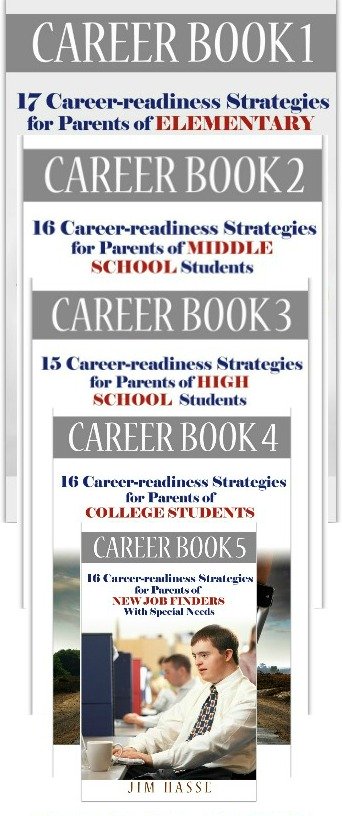Career Readiness Learning: Tips for
High School Students with Cerebral Palsy
By Jim Hasse, ABC, GCDF, Disability Employment Expert
_________________________________________________________
As a resource for effective career readiness learning, Career Book 3 summarizes the track you can take as a parent in effectively coaching your high school student who has cerebral palsy (CP). It's available as an eBook and as a paperback.
Career Book 3: Confidence booster
Here's why you need to read this book of strategies for high school students. It shows how leveraging disability worked for me in the mainstream job market -- even though I walked and talked with difficulty due to CP.
For me, this book's 15 career-readiness strategies were a confidence boosters because, together, they provided me with a quick career readiness assessment.
In this quick read (about 40 minutes), you get:
- Expert advice
- Potential pathways
- Mainstream orientation
Now is the time to help your high school student with CP tap disability's edge in today's job market.
The steps you take now will help your youngster build a meaningful career.
15 strategies for mentoring a high school student
During the 1980s, I didn’t have an opportunity to tell my mom about what I had learned about developing a career as an individual with CP.
These are tested strategies which now, decades later, may help you provide a career readiness assessment for your own youngster.
Growing in Self-confidence
Strategy 1 - Develop
Emotional Intelligence
Strategy 2 - Collect
Resume Writing Tips
Strategy 3 - Become Familiar with Today’s Work Options
Strategy 4 - Realize Disability Is Becoming Irrelevant
Strategy 5 - Explore Post-secondary Options
Strategy 6 - Know How to Set Goals
Discovering Disability’s Competitive Edge
Strategy
7 - Learn How to
Diffuse Stress
Strategy
8 - Develop Problem-solving Skills
Strategy
9 – Play the “Exception” Trump Card
Strategy
10 - Identify a Team Role That Has the Right Fit
Strategy
11 - Follow a Plan for Maintaining Motivation
Strategy
12 - Use Career Clusters to Guide Career Planning
Strategy
13 - Understand Ingrained False Assumptions
Strategy
14 - Know ADA’s Basic Provisions
Strategy
15 - Develop a Strategy for Disclosing Disability
Series of Career Books: Get all 5
Each of these five Career Books takes about 40 minutes to read.
Each illustrates and summarizes the essential career development strategies to follow for your youngster’s age group – all based on the road map recommended by National Career Development Guidelines (NCDG) and my experience as a Global Career Development Facilitator and as a person with cerebral palsy and mainstream work experience.
Get all five Career Books.
Excerpt from strategy 9
... Your high school student is in a unique position to change perception one person at a time. You can help him or her prepare for the role of an educator during job searches.
The task is to show prospective hiring managers he or she does not fit their preconceived notions of a person with a disability -- that your mentee is indeed the “exception” to sometimes long-held beliefs.
That means your youngster must begin to actively position him or herself as the exception to those misconceptions, which are usually based on lack of knowledge. Those false impressions may have roots in misunderstandings picked up during the hiring manager’s childhood. They have never been challenged in the hiring manager’s mind -- until the individual you’re mentoring appears as a job candidate.
Here’s the good news. Getting hired is not crucial at this point. As a career coach, you have time to counsel your high school student, and he or she has time to learn these basic problem-solving strategies for addressing misconceptions about disability.
Since misconceptions usually stem from lack of information, you have an opportunity to counsel your high school student in showing he or she doesn’t fit the hiring manager’s preconceived notions. That tends to “unfreeze” job interview situations so your “now-grown-up kid” can go on to explain why he or she is the best candidate for the job at hand ...Get Career Book 3 as an eBook or as a paperback
Return from Career Readiness Learning to Part-time Jobs
Go to Cerebral Palsy Career Builders
This is Creative Commons content. You can freely and legally use, share and repurpose it for non-commercial purposes only, provided you attach this sentence and the following attribution to it (including the two links):
Originally written and illustrated by Jim Hasse, ABC, GCDF, owner of Hasse Communication Counseling, LLC, who, as a person with cerebral palsy, served for 10 years as a vice president in a Fortune 500 company during his 29-year career in corporate communication. He’s an Accredited Business Communicator, certified as a Global Career Development Facilitator and author of 14 Amazon books about disability awareness and disability employment issues.






